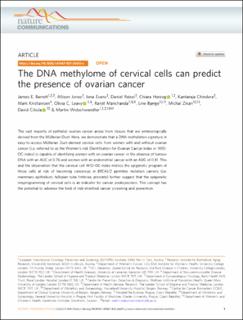| dc.contributor.author | Barrett, James E. | |
| dc.contributor.author | Jones, Allison | |
| dc.contributor.author | Evans, Iona | |
| dc.contributor.author | Reisel, Daniel | |
| dc.contributor.author | Herzog, Chiara | |
| dc.contributor.author | Chindera, Kantaraja | |
| dc.contributor.author | Kristiansen, Mark | |
| dc.contributor.author | Leavy, Olivia C. | |
| dc.contributor.author | Manchanda, Ranjit | |
| dc.contributor.author | Bjørge, Line | |
| dc.contributor.author | Zikan, Michal | |
| dc.contributor.author | Cibula, David | |
| dc.contributor.author | Widschwendter, Martin | |
| dc.date.accessioned | 2022-10-10T12:13:09Z | |
| dc.date.available | 2022-10-10T12:13:09Z | |
| dc.date.created | 2022-05-19T13:36:46Z | |
| dc.date.issued | 2022 | |
| dc.identifier.issn | 2041-1723 | |
| dc.identifier.uri | https://hdl.handle.net/11250/3025114 | |
| dc.description.abstract | The vast majority of epithelial ovarian cancer arises from tissues that are embryologically derived from the Müllerian Duct. Here, we demonstrate that a DNA methylation signature in easy-to-access Müllerian Duct-derived cervical cells from women with and without ovarian cancer (i.e. referred to as the Women’s risk IDentification for Ovarian Cancer index or WID-OC-index) is capable of identifying women with an ovarian cancer in the absence of tumour DNA with an AUC of 0.76 and women with an endometrial cancer with an AUC of 0.81. This and the observation that the cervical cell WID-OC-index mimics the epigenetic program of those cells at risk of becoming cancerous in BRCA1/2 germline mutation carriers (i.e. mammary epithelium, fallopian tube fimbriae, prostate) further suggest that the epigenetic misprogramming of cervical cells is an indicator for cancer predisposition. This concept has the potential to advance the field of risk-stratified cancer screening and prevention. | en_US |
| dc.language.iso | eng | en_US |
| dc.publisher | Nature | en_US |
| dc.rights | Navngivelse 4.0 Internasjonal | * |
| dc.rights.uri | http://creativecommons.org/licenses/by/4.0/deed.no | * |
| dc.title | The DNA methylome of cervical cells can predict the presence of ovarian cancer | en_US |
| dc.type | Journal article | en_US |
| dc.type | Peer reviewed | en_US |
| dc.description.version | publishedVersion | en_US |
| dc.rights.holder | Copyright 2022 The Author(s) | en_US |
| dc.source.articlenumber | 448 | en_US |
| cristin.ispublished | true | |
| cristin.fulltext | original | |
| cristin.qualitycode | 2 | |
| dc.identifier.doi | 10.1038/s41467-021-26615-y | |
| dc.identifier.cristin | 2025651 | |
| dc.source.journal | Nature Communications | en_US |
| dc.identifier.citation | Nature Communications. 2022, 13, 448. | en_US |
| dc.source.volume | 13 | en_US |

